
Hearing in rabbits
All mammals share the same basic ear structures, so what we've learned about humans can be applied to other mammals. Here we learn in-depth about rabbit hearing.
Rabbit ears are, anatomically, very similar to our own, because most mammals share the same basic ear structures. The outer ear, known as the pinna, is very different because rabbits need to rely more on their hearing to detect predators. Domestic rabbits can suffer from hearing problems due to selective breeding for a 'cute' look.
Basic rabbit hearing
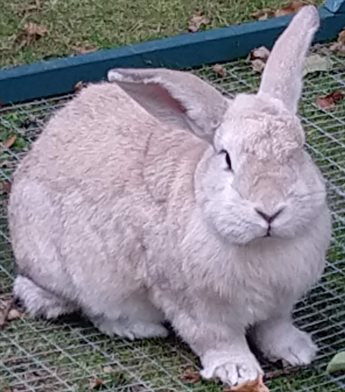
A domestic up-eared rabbit listening to the viewer and to something to her left.
Sometimes this will make up-eared rabbits’ ears lop (fall over) briefly, as the weight of blood overwhelms the muscles holding the ear up. This can also happen if they’re very relaxed, or very unwell.
Lop-eared rabbits
Lop rabbits are a popular domestic pet because they look cute, but their anatomy causes serious health issues.
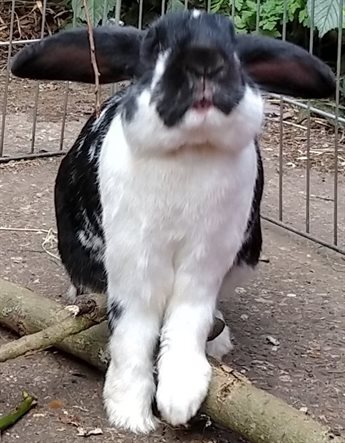
This lop-eared rabbit looks very funny, like he is flying! He's just coming back down from stretching up to eat some forage.
What are the problems?
Unsurprisingly, a lot of lop rabbits are hard of hearing or even deaf. The anatomy of the lop means their ear canal contains a kink which narrows it, so sound can’t travel down to the eardrum so easily. You can see this in action by folding a hosepipe or straw: when the liquid tries to go through, it cannot pass the kinked section very easily or at all.
In addition, the kink doesn’t allow ear wax to drain out of the ear properly, so it builds up. This can cause deafness or, more seriously, ear infections.
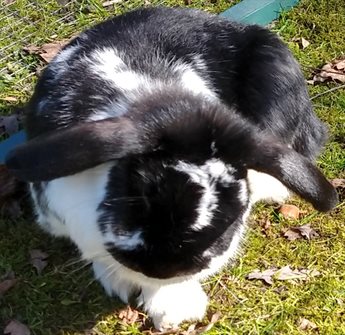
The lop rabbit scratching his ears: if he does this often, it could mean he has an ear infection and needs to go to the vet. The vet will prescribe eardrops and possibly an antibiotic. It is unpleasant to administer for rabbit and owner!
A lot of deaf lops sleep very soundly when they are in the right home and know it is safe. Sometimes this is when you find out your bunny is deaf, as you wake them up by them seeing you (rabbits often sleep with their eyes open, because they are prey animals) or you poking them to make sure they’re not dead! Such events are known as the ‘dead bunny flop’.
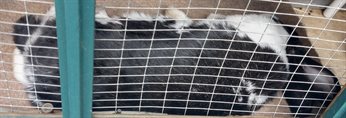
This lop rabbit is so deaf he will sleep through anything!
Some rabbits have what’s called ‘helicopter ears’: one up and one down! For some, this is always the same, whereas others change which ear it is, or are sometimes all-lopped or all-upright!
Wild rabbits and their up-eared domestic cousins have a dish-shaped pinna (external ear) which funnels sound into the ear canal, like a satellite dish or radio telescope.
Up-eared rabbits can swivel their ears up to 270° and use their ears independently, to follow two sounds at once.
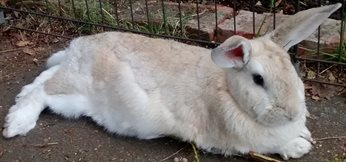
This rabbit is now listening to something ahead with both ears. It is quite warm, her ears have fallen slightly from normal.
The outer ear also acts as a radiator: rabbits can’t sweat like we do, or pant like dogs, so regulate their temperature by pumping blood into their ears. Rabbits in cooler climates have smaller ears so they don’t lose too much heat; in these areas the air also tends to be denser so sound travels much further, so they don’t need such large ears!
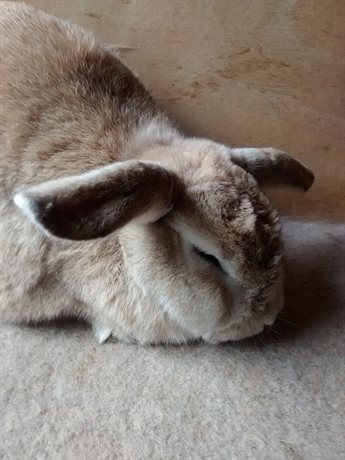
This rabbit is now very relaxed, her ears have become horizontal!
What causes lopping?
The gene that relates to lopped ears may have originated in hot countries, as having lots of blood in the ears all the time could force the ears down. Anatomically, there are significant skull differences between lop rabbits and up-eared rabbits due to selective breeding (i.e. human breeding for the pet trade).
Up-eared rabbits have three interlocking pieces of cartilage that hold their ear upright, but lops have a gap between the cartilage pieces, meaning it cannot be kept upright and so lops over.
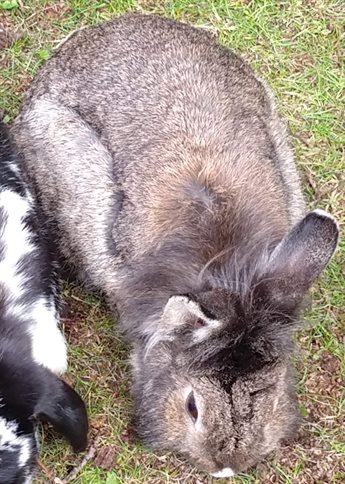
This is a lionhead rabbit. She has much smaller ears than the fawn rabbit above or the lop rabbit. Her fur is also longer so she may have 'cold climate' genes.
Lops also cannot turn their ears like up-eared rabbits: some have no control over their ears at all (especially the very long eared English Lops and similar breeds) whereas some can swing their ears towards a sound. Some truly deaf lops will also swing their ears towards something they’re interested in, a leftover reaction from rabbits who can hear!
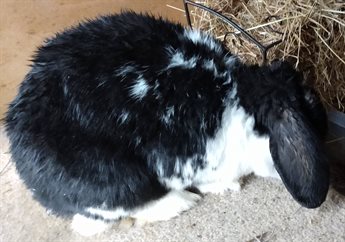
This lop rabbit still 'listens' by swinging his ears forward, but in truth he can only perceive very deep (bass) sounds such as boats and helicopters.
Other ear things
As in humans and other mammals, the inner ear also contains the vestibular system. If this gets damaged, rabbits can suffer from head-tilt, rapid eye movements and loss of balance. Trauma (physical injury), infection and overgrown tooth roots can all impact the inner ear.
Lop rabbits also suffer from having shorter skulls, meaning their teeth don’t always line up correctly. Like rodents (rats, mice etc.), rabbits and other lagomorphs (hares and pikas) have teeth that grow constantly and are worn down by eating grass and hay as well as by chewing sticks and branches. Lop rabbits and other short-skulled breeds, including lionheads (see the brown rabbit above) and Netherland Dwarfs, may not be able to wear their teeth down evenly which can lead to spurs and hooks on their teeth, which will damage their tongues and cheeks. Sometimes the incisor (cutting) teeth at the front of the mouth become overgrown and the rabbit is unable to eat at all.
Lack of space in the skull for tooth roots can also lead to problems with eyes, tear ducts, and even the ears.
Want to know more about rabbits?
Check out the Rabbit Welfare Association and Fund
Learn more about hearing